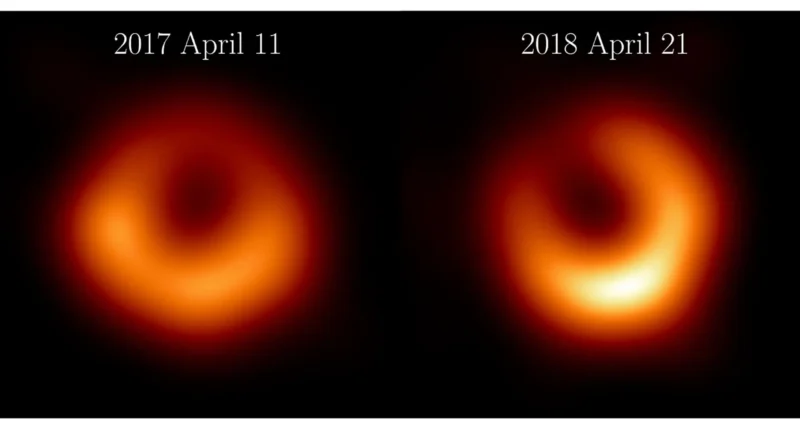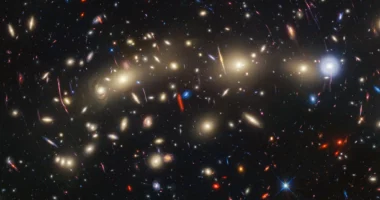Hello darkness, our old friend, we’ve come to stare at you again.
At the center of Messier 87, a giant galaxy 55 million light-years from Earth, is a darkness 24 billion miles across and as massive as 6.5 billion suns — a trapdoor to infinity called a black hole.
In 2017, a group of astronomers operating the Event Horizon Telescope, a world-spanning network of radio telescopes, produced an image of the black hole in Messier 87, or M87, the first image of any black hole ever. It revealed a fiery, slightly lopsided doughnut of hot gas circling a dark emptiness like water circling a drain, precisely as Albert Einstein’s theory of general relativity had predicted in 1915. When the resulting picture was revealed in 2019, it made the front page of news outlets around the world. It is now in the collection of the Museum of Modern Art in New York.
The same team of scientists have done it again, this time even better. In 2018, a year after capturing the first image, the astronomers stared again into M87’s darkness with a slightly enlarged network that provided higher resolution. The result, published last week in the journal Astronomy and Astrophysics, shows the same lumpy doughnut and the same central hole in even tastier detail, suggesting that the astronomers had done things right the first time around.
“The first image of a black hole looked so similar to the mathematical predictions that it almost seemed like a fluke,” Dominic Chang, a physics Ph.D. candidate at Harvard who works on the Event Horizon team, said in a news release issued by the Center for Astrophysics/Harvard & Smithsonian in Cambridge, Mass., where the project is based.
“Getting the opportunity to make new tests using new data, with a new telescope, and seeing the same structure, is a crucial confirmation of our most significant conclusions,” he said.
There was one change to the ring around M87’s black hole. Its brightest lump had shifted roughly 30 degrees counterclockwise around the ring relative to where it had been a year earlier. The astronomers said they had predicted that the hot spot would move.
“While general relativity says the ring size should stay pretty fixed, the emission from the turbulent, messy accretion disk around the black hole will cause the brightest part of the ring to wobble around a common center,” Britt Jeter, a postdoctoral fellow at Academia Sinica Institute for Astronomy and Astrophysics in Taiwan, said in the news release. “The amount of wobble we see over time is something we can use to test our theories for the magnetic field and plasma environment around the black hole.”
Sheperd Doeleman, a researcher at the Center for Astrophysics and the founding director of the Event Horizon collaboration, added in an email: “In other words, M87’s supermassive black hole is behaving just as we thought it would.”
To Einstein, black holes were one of many troublesome predictions to emerge from general relativity, which attributed what we call gravity to warps in the geometry of space-time. One was that the universe was expanding. Another was that if too much matter or energy was concentrated within a certain radius — now called the event horizon — it would collapse forever into a hole in space-time from which not even light could escape.
Einstein agreed with the math but thought that nature would somehow have better sense than to give form to such weirdness. But scientists now know that the universe is full of black holes; experiments like the Laser Interferometer Gravitational-Wave Observatory, or LIGO, have heard them bang together, and the Event Horizon Telescope has brought them to visceral reality. Many black holes are dead stars that collapsed when they ran out of thermonuclear fuel, but a giant black hole millions or billions of times as massive as an ordinary star seems to lie at the center of most galaxies. Astronomers still don’t know how they came to be.
Thanks to a quirk of nature, two of these supermassive holes — in M87 and at the center of our own Milky Way galaxy — are big enough in the sky to be resolved and studied by the Event Horizon Telescope. An image of our own black hole, called Sgr A*, which sits 27,000 light-years from Earth in the direction of the constellation Sagittarius, made its debut in 2022.
We can expect more of these portraits of doom. Dr. Doeleman and his team plan to continue adding to their network and to eventually create a black hole movie. Eat your heart out, Netflix.






